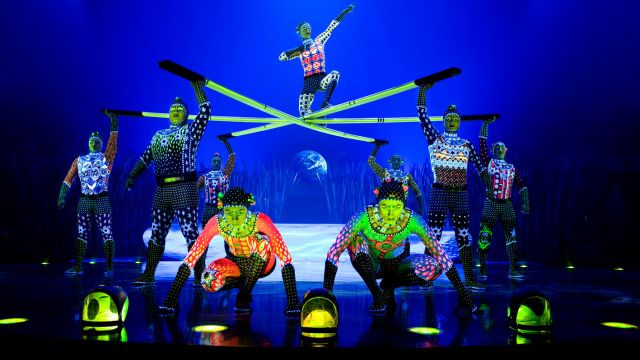Cirque’s Towering Totem
The evolution of mankind, no less, is the mighty canvas for Cirque du Soleil’s latest touring extravaganza. But is it Theatre? FRANK HATHERLEY peeks under the big top.
What should we call Cirque du Soleil? Is it Theatre or Circus or Big Top Cabaret or Massive Musical or what?
New York’s Drama Desk has no doubt. This respected posse of Broadway critics and reporters gave its 2013 Drama Desk Award for Unique Theatrical Experience to Totem, the latest themed entertainment from Cirque du Soleil.
The show was written and directed by Canadian theatre giant Robert Lepage in 2010, the same year he directed (“extravagantly”) the first opera of Wagner’s Ring Cycle for the Metropolitan Opera of New York.
So it’s definitely Theatre: but BIG Theatre, right?
And it’s coming your way, trailing reviews to die for. “What’s the next level after impressed?” asked The New York Times critic. “Amazed? Awe-struck? Whatever it is, that emotion arrives often in Totem.”
The grand theme this time is nothing less than “the evolution of mankind”, from murky swamps to outer space, acknowledging the totem pole of species to which we inevitably belong. Phew!
Following a season in Auckland,the Totem company pitches its distinctive, giant blue-and-orange tent in Moore Park, Sydney, first stop in a ten-month Australian tour.
The company has toured Australia seven times since 2001. If you’ve seen them live — or one of their filmed shows — you’re unlikely to forget their terrific sets, cutting-edge lighting and projections, glittering costumes, spectacular choreography and gravity-challenging acrobatics.
Cirque du Soleil is a rags-to-riches, fairy tale story from the humblest Street Theatre beginnings.
***
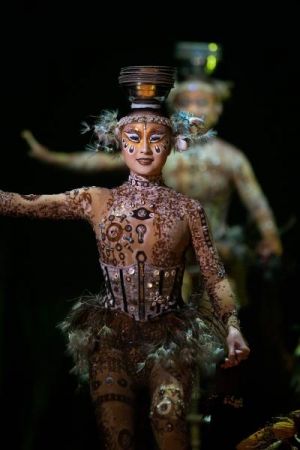 Once upon a time in Baie-Saint-Paul, one of French-speaking Quebec’s oldest towns, there roamed a band of strolling entertainers. They called themselves Les Echassiers, The Stilt-walkers.
Once upon a time in Baie-Saint-Paul, one of French-speaking Quebec’s oldest towns, there roamed a band of strolling entertainers. They called themselves Les Echassiers, The Stilt-walkers.
It was 1979. One of the band, Gilles Ste-Croix, had originally taught himself to walk on stilts in order to more easily pick apples. Another, Guy Laliberte, played the accordion, ‘breathed fire’ and nursed a fierce ambition to form a new kind of animal-free circus.
By 1984 the two visionaries had created Cirque du Soleil (Circus of the Sun). Three formative years of local touring were tough going but their big breakthrough came in 1987 when the young company was invited to the Los Angeles Festival. They were a hit.
How did they label themselves? “First we were street players trying to be a circus,” Laliberte told a US magazine in 2009, “and then we were a circus trying to be a theatrical troupe, then we were a theatre with circus performances, and then we became a musical theatrical event with circus performers.”
Laliberte, 55 and one of the richest men in Canada, remains CEO. Ste-Croix is Senior Vice President of Creative Content.
The entertainment juggernaut that these ex-stilt-walkers co-founded is now perhaps the world’s largest theatrical company, employing over 4,000 in its global operations. Half are based at the Headquarters in Montreal.
Astonishingly, Totem is just one of 19 mega-shows they have currently running worldwide. Ten are under travelling Big Tops or touring to big arenas, two are resident shows (in Florida and Mexico) and seven are in residence at various ritzy Las Vegas showrooms.
That’s seven major shows running in Las Vegas at the same time!
***
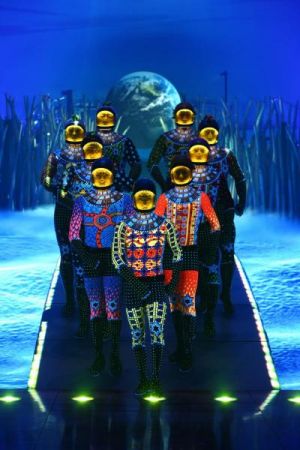 Francis Jalbert is fulltime Publicist with the Totem company. When we speak he’s in Auckland where the company is preparing for the big move to Sydney.
Francis Jalbert is fulltime Publicist with the Totem company. When we speak he’s in Auckland where the company is preparing for the big move to Sydney.
“All our equipment is packed into 85 containers,” he tells me. “We’ll ship them to Sydney and they will travel by train in Australia from one city to the other. When we leave Australia they will go on a boat towards our next destinations, to Asia, Japan...”
Jalbert is from Quebec and has a rich French accent. “Cirque du Soleil makes my region shine around the world,” he says. He’s been “living and breathing Totem for the past three years”.
“There are 120 people working on the show, including 46 performers. We come from 21 different countries and speak 11 languages. It’s like a little United Nations travelling around.”
With 19 Cirque productions worldwide, I suggest there must be almost continuous auditions and recruiting.
“Our casting department has 26 Casting Scouts. They are constantly looking around the world for the best performers out there – gymnasts, singers, divers, synchronised swimmers, etc.
“40% of our artists come from a gymnastic background. They might have been competing at national or international levels. We have a strong relationship with the various Gymnastic Federations and we never try to steal an athlete from competition. We let them know that we are a possible career opportunity after they’ve done with competing.
“If we select them we invite them to our Headquarters for what we call General Formation. Over four months we transform athletes into artists.
“They will continue their various disciplines and skills but in a whole new way. And they will learn how to sing, how to dance, how to play a character, how to connect with the audience.”
Arriving in a new city it takes eight days to assemble and prepare the Big Top and the entire Totem set and rigging — plus reintroducing a dynamically fit and rested cast.
“Robert Lepage, our director, is always interested in the latest technology that can be integrated with human performance. He wanted to bring a technological element to this show that had never been seen inside a Big Top before.
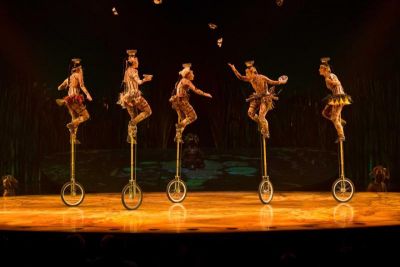
“There’s a moving platform in the centre that opens up, is raised, moves forward, moves backward.
“Our set looks like a marsh, but instead of water we have video projections. Throughout the whole show we project images that were specially shot all round the world – for instance, a waterfall that was shot in Iceland, lava that was shot in Guatemala.
“We create interaction in real time with the projections. As the performers walk on the platform the projected water moves under their feet. As they walk on projected sand their steps appear behind them in the sand. It really gives the impression that we are all in this environment.”
So what would he now call Totem — Circus or Theatre?
“It smells like Circus, but not completely,” says Francis Jalbert. “It smells like Theatre, but not completely. It smells like a Musical because of all the live music, but it isn’t. And if you go backstage, with all the artists training in the gym, you’d say it’s a mix of Sport and Theatre.”
***
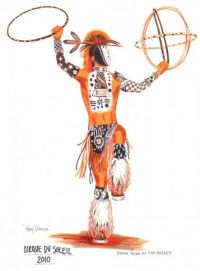
A notable Australian in Totem’s international production team is Costume Designer Kym Barrett. She categorises the show, when challenged, as “Theatrical Circus”.
After a Theatre Studies degree at the University of New England, Armidale, Barrett did the three-year Set and Costume Design course at NIDA.
Now she’s regarded as one of Hollywood’s leading costume designers, with a string of credits that began with Baz Luhrmann’s 1996 small-budget masterpiece Romeo + Juliet. The costumes in that were remarkable, as were her contributions to the three Matrix movies.
After 20 years in major Hollywood movies, “I really wanted to go back to Theatre, and Totem was a way for me to do that”.
She joined the Totem creative team under Robert Lepage “about 18 months before we opened. We were all working on lots of individual projects in other parts of the world.
“It’s very organic at the beginning. There are so many unknowns. How many performers? What are they going to be doing?
 “Each time we got back together there’d be new sets or props or they’d have chosen some new acrobatic acts or a script had been formatted to include a special performer. Over six months we came up with the framework for the show and then we could start the illustrations.
“Each time we got back together there’d be new sets or props or they’d have chosen some new acrobatic acts or a script had been formatted to include a special performer. Over six months we came up with the framework for the show and then we could start the illustrations.
“We were all very well connected via the internet. I’d send pictures to the set people, and they’d send pictures to me. So then we could put all our presentations together.”
Her Totem designs are based on extensive research. She has mixed the documentary reality of evolving animals, birds and plants with traditional and tribal designs.
It’s a dazzling mix of colours and textures. The stretch velvet leotard worn by The Crystal Man, for instance, is a glittering mosaic of 4,500 reflective components.
“I was inventing my own reality but there’s a definite documentary patina.”
Kym Barrett’s return to Theatre was invigorating for her. “Now after a couple of movies I do a theatre show.”
She’s already on board for a 2015 Cirque du Soleil super-production inspired by blockbuster movie Avatar. She says she’s up for theatre work in Australia, but I reckon the STC/MTC would have to book her well ahead.
***
There’s only one Aussie among the large cast and crew on the tour. He’s Daniel Fulloon, a Swing Technician, and he couldn’t be happier.
“In Cirque du Soleil’s world a Swing Tech is a ‘Jack of all trades’,” he explains. “I can work on eight of the 13 technical tracks it takes to run the show.
“A track is a set of cues that each department is responsible for. These cues could be operating the lighting or sound console, making sure all the artists have the correct props, opening trap doors for artists to enter or exit from, and running the automation system.
“On a daily basis my job is to make sure that if any technician was to get sick or injured, I would be able to fill the position without affecting the show quality.”
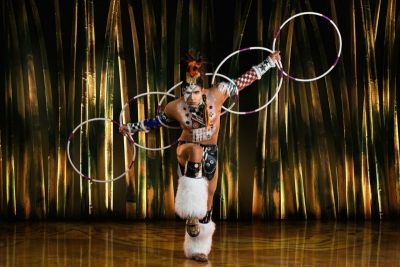
How did this young man from Toowoomba get into such international company?
With an American mother, Daniel’s a dual Australian/US citizen. After High School, where he had got involved in the technicalities of end-of-year shows, he headed for a summer school at the Stagecraft Institute of Las Vegas.
This led to contacts with the Cirque du Soleil recruiting team and an eventual job as carpenter/stagehand on The Beatles LOVE at The Mirage, Las Vegas.
“I really didn’t have all the technical knowledge required,” he admits. “But the Cirque team were willing to overlook that for someone who was passionate and driven in the technical realm.
“I was called into the office in my first week and told to ‘stop acting like a kid in a candy shop’. There are so many amazing toys to play with, but now I’ve learnt to do it in a more professional way.”
After a while he asked to be transferred to a touring show.
“The best days for me,” says Daniel, “are when something goes a little different than planed but the audience never knows. In Ottawa, Canada, we had a rainstorm that really flooded our site. I’m talking ‘up to our knees in water’.
“We were all called into work early. Could we get it ready for the show that night? Every single technician responded quickly and efficiently, doing what needed to be done. Within 6 hours the only things that showed signs of what had happened were our sopping wet boots.”
Sydney – From October 28, Entertainment Quarter, Moore Park
Melbourne – From January 21, Flemington Racecourse
Brisbane – From April 10, Northshore Hamilton
Adelaide – From June 11, The Plateau in Tampawardli
Perth – From July 31, Belmont Racecourse
Photos by OSA Images. Costume designs by Kym Barrett.
Originally published in the November / December 2014 edition of Stage Whispers.
Subscribe to our E-Newsletter, buy our latest print edition or find a Performing Arts book at Book Nook.

